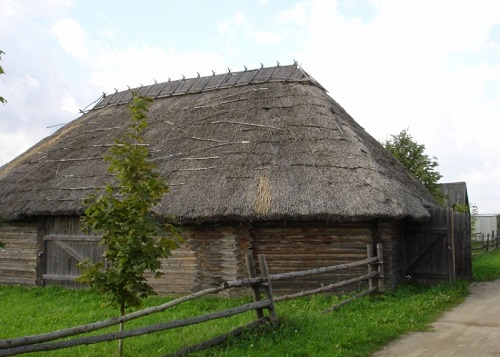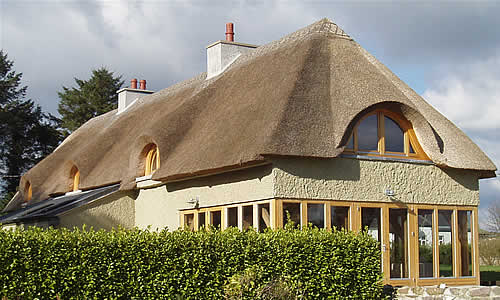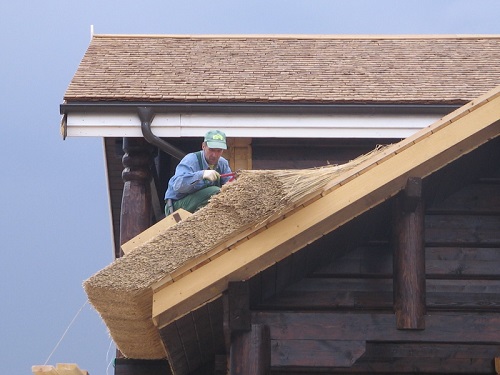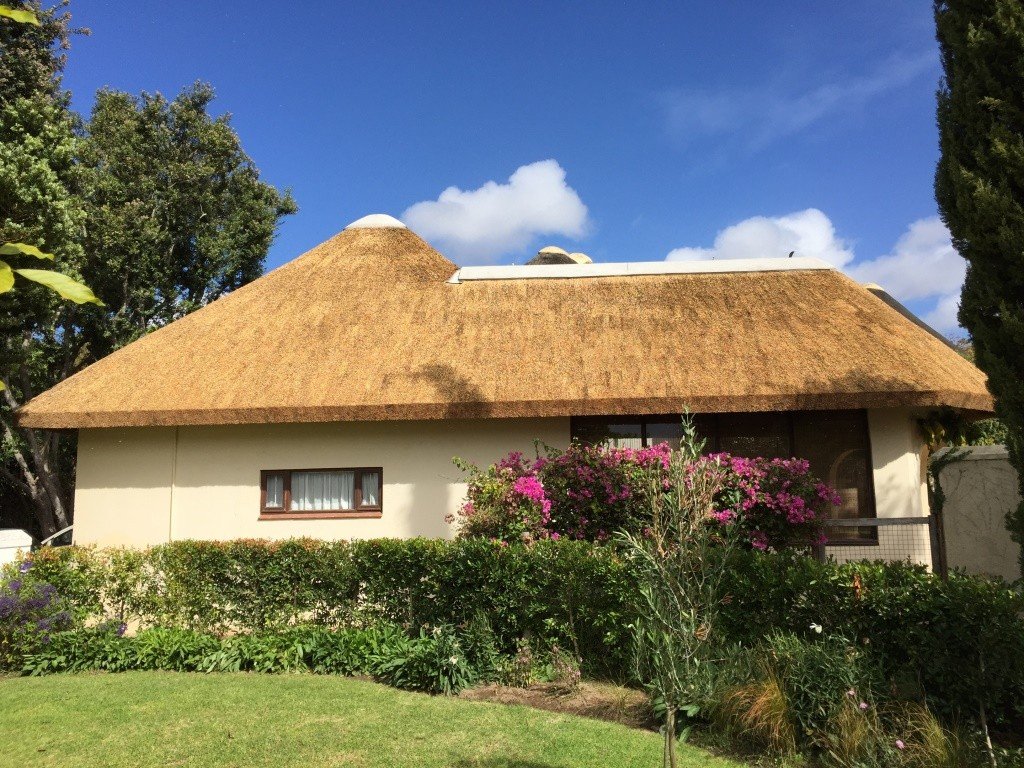It’s not without reason that folk wisdom says: “Everything new is well forgotten old ...” The increased interest in using today an old, like the world, thatched roof covering confirms this.
Modern man finally began to think about ecology, about preserving the natural environment in the world around us. The use of natural materials that our ancestors used in the distant and not very distant times is again considered expedient and quite practical.
Some of you grin: "Found something to praise." Wait, do not deny that you do not quite know. In many cases, of course, straw cannot compete with the latest roofing materials, such as metal tiles, decking or flexible roofing. But do not forget about the wonderful practical properties of this material.
For suburban low-rise housing construction in some areas of our vast homeland, it has been successfully used and pleases its owners for many years. The thatched roof perfectly protects not only the homes of Europeans and residents of Asia, but also finds application in the construction of dwellings or outbuildings in America and Australia.
Content
About the benefits of a thatched roof

Most often, straw straws with long stems or wild reeds, reeds and other cereal plants are used as a natural roofing. The most durable of them is reed, which grows in water, has fairly high stems, and most importantly, it is naturally resistant to sudden changes in temperature, frost and high humidity.
The straw roof made of reed straw can last up to 50 years and even more if the correct slope is chosen and all roofing works were carried out in accordance with the requirements for the installation of such roofs. The involvement of qualified specialists in installation work will extend the life of such a roof.
It is worth noting that this material is not to the liking of rodents, which means it is not eaten by them, it does not absorb moisture and is resistant to the most extreme weather conditions.
If we use flame retardants specially created for straw coatings, then the fire resistance of straw increases sharply and even becomes comparable to similar indicators of other roofing coatings, such as bitumen shingles. Such treatment of a straw coating with these protective substances adds to the increase not only the refractory, but also the water-repellent properties of this natural material.

Do not be afraid to use flame retardants. They are environmentally friendly, non-toxic and odorless.
Thatched roof has another very important advantage - it does not require special ventilation wells or fans to maintain a stable temperature not only in summer but also in winter.
In addition, the straw coating gives the whole house an original look and unique flavor. The popularity of thatched roofs is constantly growing, not only in our country, but throughout the world due to its excellent practical characteristics and reasonable price.
Material and roof requirements
For thatched roofs, freshwater cane of very high quality is usually used, which should consist of strong, flexible and straight stems without leaves. Do not use cane that is moldy, rotten, charred, or mixed with different grass and branches.
Consider what the angle of the roof should be for convenient laying of the reed:
- at least 30 °, if the roof is small (the length of the ramps is not more than 2 meters), and the dormer-windows have fairly even slopes;
- at least 40 ° if the roof is large;
- not less than 30 °, if dormers have round slopes.

If the angle of the roof is less than 45 °, then there is a significant decrease in the service life of the roof of straw.
Here are some of the features of creating a thatched roof structure
- The minimum slope of the usual roof should be close to 45 °, while using old reeds, cattail tops and loose stems for the first layer.
- Thatched roof allows the presence of no more than 2% of loose stems in the total mass of reed, as well as the need to observe the thickness and length of individual stems, sheaves of reed and the layer itself;
- Depending on the wind load in the construction region, the straw is compressed (from 4 to 6 cm) in places where it stands beyond the edge of the lower structure. Therefore, the compression is carried out without gaps towards the outer surface so that the reed fits snugly on the inner edges of the roof and at the same time protrudes beyond the bar that presses the straw by about 15 centimeters.
- For fastening, galvanized steel wire clips are also used. The first of the clamps is placed at a distance of 20 cm from the bar for pressing, and the second - 12 centimeters from the first. There should be a distance from 28 to 30 cm to each next layer.
- Sheaves are stitched to the corner beams using a thin steel wire (pitch - 22 cm), while the reed is fastened very tight, observing the distance for the clamps described earlier.
- In cases where the slope of the thatched roof is more than 40 °, the distance between the top of the roof and the pressure bar is not more than 7 meters, and the length of the reed stalks is less than 1.5 meters, then the thickness of the reed layer laid near the base of the roof should be at least 25 cm and the thickness of the layer near the top of the roof should not be less than 22 cm. In this case, it is necessary to create a wear layer that will have a thickness of at least 9 cm. In those cases when the distance between the top and the plank is more than 7 m and the roof slope is less than 40 °, and the length of the reed stems is more than 1.5 m, then Thickness of layers will have a magnitude of 28 cm and 25 cm, and the wear layer thickness of about 10 cm.

Thatched roof will turn out smooth if it is installed on a flat and solid foundation. Reed can be of different colors, lengths and thicknesses, which is very often seen on a new roof. However, all the differences are almost completely eliminated themselves after a year of its operation and do not in any way affect the quality of the straw coating, which depends on the place of collection of this material and the season of its harvesting.
During the installation of the roof ridge, it is ensured that the reed protrudes to a height that would allow a distance of no more than 6 cm between the ridge and the reed. In addition, the length of the visible stems should not exceed 6 cm.
All these installation requirements must be strictly observed for the proper installation of thatched roofs.
DIY thatched roof, issue price
Doing installation work with your own hands will significantly reduce the cost of building a house or an outbuilding. But one owner is unlikely to be able to cope with all the work on laying the roof. It is better to invite friends and at least one qualified roofer as a consultant and the head of your friendly team. You can learn this very difficult task yourself.

For training, it may take 1 - 2 years, and for the acquisition of skills and qualifications of a master in laying a thatched roof, it takes 3 to 5 years.
To carry out all the necessary work on laying natural straw on the roof of a house of the most average sizes, it usually takes 2 or 3 weeks.
It is recommended that the slope of the thatched roof be 35 ° (or more), and the thickness of the roof covering and the methods of laying straw should be selected depending on the particular of the eaves.Systems for draining water are created on an individual basis, given that on such roofs there are usually no gutters and pipes for a drain.
It used to be that a thatched roof is a sign of the backwardness and poverty of homeowners. Today, such a roof in the developed countries of Europe is considered to be elite and expensive. And in some places the cost of one square meter of straw cover is about 150 euros.
Such a high price of this material is determined: its deficit, environmental safety and, of course, manual installation of the roof, as well as some other factors. But despite this, in Russia, the demand for thatched roofs made using European technologies is growing every year. Ultimately, the price of thatched roof is quite comparable to the tiled roof, since it does not require installation of hydro and thermal insulation.
DIY thatched roof, sheaf garter
The quality of the thatched roof will vary in places, which is explained by manual roofing and sometimes violation of installation requirements and materials.
To obtain a good result, different methods of bundle shear are used. Let's consider some of them.
1. The method of firmware wire.

If there is access to the roof not only from the outside, but also from the inside, then the firmware is performed by two people together. In this case, one of them is located outside, and the other directs the needle with the wire threaded from the inside. The guide helps the upper to return the needle down bypassing the beam encountered.
If there is no access to the roof from the inside, then a special rounded needle with rings for attaching the wire is used for firmware. This method requires much more strength and skill, and therefore it is used very rarely.
2. The method of flashing with nails.
This method is convenient and quick to execute and is performed if the grill is properly mounted to withstand the entire load. Its disadvantages include high consumption of nails, which can significantly increase the cost of firmware.
3. The method of flashing firmware.
Banners are wooden pieces, wire or stalks of bamboo 8 mm long. This method can also be used for attaching to the roof bunches of stalks of reeds, often used in decorating the roof, as well as its individual elements.
4. The method of firmware using screws.
The screws to which the wire is attached serve as a replacement for the wire passed under the roof. Fastening is performed to the crate or roof beam. In this case, the wire is attached to the screw in advance, providing the length necessary for flashing the area of the entire roof. This is a very simple and quick method that can be performed even by one person, so we will consider installing the thatched roof on the screws in more detail.
With this type of installation, the sheaves pressed by the wire are fastened to the covered flooring. As sheathing boards, ordinary or glued fiberboard, as well as multilayer plywood or some other similar materials, are used.

The minimum thickness of the shield is considered to be 18 mm, it depends on the length of the mounting screws.
Laying sheaves of straw is an important step in the insulation of the roof, while they do not make a gap between the sheaves and the lower structure, since it is quite tight. Separating the inside from the outside helps to get a comfortable, fireproof and reliable thatched roof.
The surface of the lower layer should be dry, strong enough, even, clean and without damage. And its tightness is also an important factor. You should pay close attention to the attic windows and chimneys passing through the thatched roof.
So, the creation of a thatched roof is a rather laborious and painstaking process. However, the result will please the owners with this environmentally friendly, relatively inexpensive and highly reliable roof that will last you a long time.





Alas, no comments yet. Be the first!